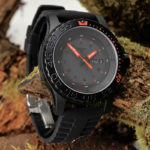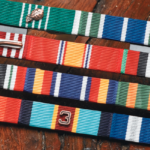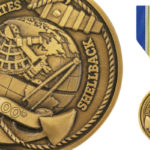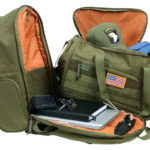Air Medal History
Service: All Services
Instituted: 1942 (Retroactive to 8 September 1939)
Air Medal Criteria: Heroic actions or meritorious service while participating in aerial flight, but not of a degree that would justify an award of the Distinguished Flying Cross
Devices: Army: Bronze Letter “V” (for valor) effective 29 February 1964, Bronze Numeral;
Air Force: Bronze, Silver Oak Leaf Cluster; Navy/Marine Corps: Bronze Letter “V” (for valor), Bronze Numeral, Bronze Star, Gold, Silver Star, Gold Numeral; Coast Guard: Gold, Silver Star
Notes: During World War II, the Army Air Corps and U.S. Army Air Force employed bronze and silver oak leaf clusters as additional award devices on all decorations including the Air Medal. The same devices were used by the Army until the establishment of the bronze numeral as its unique additional award device for the Air Medal during the Vietnam War.
Authorized on May 11, 1942, the Air Medal is awarded for single acts of achievement after September 8, 1939 to any member of the U.S. Armed Forces who distinguishes him/herself by heroism, outstanding achievement or by meritorious service while participating in aerial flight. During World War II, the Air Medal was to be awarded for a lesser degree of heroism or achievement than required for the Distinguished Flying Cross. However, many Army Air Force units began to award the Air Medal on a quota basis, e.g., 20 missions equaled one medal or a Medal for every enemy aircraft shot down. Some commands carried this to extremes by awarding a DFC for every five medals. By the end of the war, over a million Air Medals were awarded (many of which were, of course, oak leaf clusters). While this might appear extreme, the generous award of the Air Medal provided combat aircrews a visible sign that their devotion and determination were appreciated by the country. It helped keep morale up in a force that suffered the highest casualty rate of the war after the Infantry.
Although the Naval Services were authorized to award the Air Medal during World War II, the numbers never approached those received by the Army Air Force amidst the European bombing campaigns. Subsequent to World War II, however, with the increased role of the Navy in joint operations, the use of the Air Medal was subtly redefined. It was still awarded for single acts of outstanding achievement which involve superior airman-ship, but of a lesser degree than would justify an award of a Distinguished Flying Cross. However, during the Korean, Vietnam and Gulf conflicts, awards for meritorious service were made for sustained distinction in the performance of duties involving regular and frequent participation in aerial flight operations. These operations include “strikes” (sorties which deliver ordnance against the enemy; those which land or evacuate personnel in an assault; or, those which involve search and rescue operations which encounter enemy opposition), “flights” (sorties which involve the same kinds of operations as strikes but which do not encounter enemy opposition) or “direct combat support” (sorties which include such activities as reconnaissance, combat air patrol, electronic countermeasures support, psychological warfare, coastal surveillance, etc.). In addition, the Air Medal was awarded for noncombat aerial achievement, such as, to air weather crews who gather major storm data by flying into hurricanes. The Air Force ceased all noncombat awards of the Air Medal with the institution of the Aerial Achievement Medal in 1988, but without a comparable peacetime medal, the other Services still award the Air Medal under circumstances not involving actual combat.
Air Medal Design
The Air Medal was designed and sculpted by Walker Hancock and is a bronze sixteen point compass rose suspended by a fleur-de-lis. In the center of the military medal there is a diving eagle carrying a lighting bolt in each talon. The compass rose represents the global capacity of American air power. The lightning bolts show the United States’ ability to wage war from the air and the Fleur-de-lis, the French symbol of nobility, represents the high ideals of American airmen. The reverse of the compass rose is plain with an area for engraving the recipient’s name. The ribbon is ultramarine blue with two golden orange stripes representing the original colors of the Army Air Force.
Medals of America also offers an exclusive online Rack Builder and military medals mounted for wear. Call us at 800-308-0849 to purchase the Air Medal or add it to your cart today.





